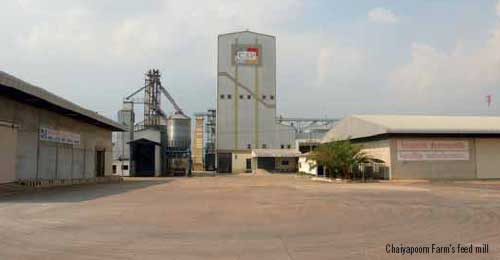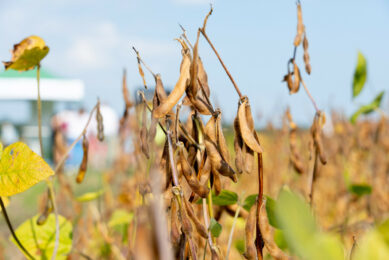Thailand’s Chaiyapoom Farm: Feed safety adds value

By simply making a good feed, the return from making good products was beyond expectation due to healthier animals and all round improvement in mill operation efficiency, according to Pramote Jirakawinvanich, managing director of Chaiyapoom Farm. The feed mill received HACCP and GMP accreditation.
By Apisit Buranakanonda
Jirakawinvanich’s motivation to have GMP and HACCP accreditation is simple. He only wants to make good feed for his animals and safe food for humans. Jirakawinvanich took up the initiative despite the fact that his feed is consumed internally for his own farms and contract growers only. GMP certification for the feed mill took three years to accomplish.
Shortly after that, Chaiyapoom Farm also received accreditation from Thailand’s Department of Livestock Development. The GMP and HACCP project required a roughly 3-4 million baht (€75,000-€100,000) investment to install nets and make facility improvements.“What GMP and HACCP gave us in return was more than what we expected. We have seen a substantial improvement in animal performance. We have reduced reprocessing time and cut loss to 2% from slightly less than 3% prior to having GMP and HACCP in place,” says Jirakawinvanich.
First mill accredited HACCP and GMP
Chaiyapoom Farm is the first feed mill producing feed for use internally that is both GMP and HACCP accredited in Thailand. The plant now produces 3,000 tonnes/month derived from 14 formulas, or 30% of its designed capacity for piglets, breeders and finishing pigs, all in bulk. The feed is totally traceable and retained samples are maintained for trace back.
HACCP accreditation took only six months to complete following GMP certification, which came after three years of hard work. The effort paid off because it satisfies customer needs. “Any quality management programme may fail if the owner is not totally committed to it,” Jirakawinvanich adds. HACCP and GMP eliminates the risk of feed-borne hazards such as salmonella. The permissible limit for bacteria is 8×105 cfu/gm, moulds 1×105 cfu/gm.
HACCP is an extension of GMP, which is made up of quality control practices that have already been firmly established by the industry. There are three critical control points (CCPs) which are determined based on risk and corrective actions used to minimise food safety hazards. If the risks involved are high and corrective action after-the-fact is not possible, then that point becomes a CCP. The CCPs are determined carefully based on collective brainstorming efforts and probable risks based on past evidence.
Processing requirements
The first CCP is pellet conditioning temperature. Therefore, a high pellet conditioning temperature of 70SDgrC has been set for starter, grower, finisher and breeder feed to terminate salmonella. For piglet feed, the pellet conditioning temperature is reduced to 50SDgrC because whey is sensitive to heat. Overcooking leads to caramelisation (Maillard reaction), which damages protein and essential amino acids and adversely affects digestibility.
The second CCP is the cooling process. The difference between cooled pellet and ambient temperature should be between 6-8SDgrC to prevent vapour condensation which can lead to mould growth. The third CCP is the magnet installed at the end of the chute to trap metal fragments. The layout and work flow is designed to maximise food safety. Raw materials are physically separated from complete feed.
The plant has a 4,000-litre paddle mixer and two pellet presses, with total capacity of 30 tonnes/hour. The mixer is regularly tested for mixing variation; coefficient of variation (CV) is 5%. Corn is used to flush the lines to prevent carryover between batches and a microtracer is used to test if the cleaning between batches is sufficient. Chaiyapoom Farm purchases raw ingredients and vitamin premixes only from approved vendors, preferably those who also have HACCP accreditation. For corn and cassava, the specs determine moisture, permissible level of aflatoxin which should be below 100 ppb, no salmonella, bacteria below 8×106 cfu/gm, and mould 1×105 cfu/gm. Crude soybean oil used in the formula must comply with the specs, for example, free fatty acid (FFA) less than 5%, phosphorus content below 200 ppm. The raw material intake is fitted with a sieve and metal detector to sort out metal and non-metal foreign objects. Metal particles are trapped again by a magnet before the feed is loaded onto the bulk truck.
EU standard
Chaiyapoom Farm’s maximum residue level for pesticides is on par with EU standards. Samples of corn and cassava are taken for testing for pesticide and heavy metal residues at least once a year. Protein sources must contain no melamine. Dehulled soybean meal and soybean meal is purchased from a trusted vendor. Soybean meal is graded by protein content and solubility, and dye adsorption tests are used to judge whether the soybean has been overcooked. Apart from being audited, vendors must submit a certificate of analysis indicating no adulteration with melamine. Apart from checking every intake by microscopy, it regularly does a cross-check by testing the samples again at a third-party lab.
To keep its feed salmonella-free, meat and bone meal are not allowed in the formula. Fish meal is only used in piglet feed. It carefully sources fishmeal from trusted suppliers and all raw materials must have a certificate of analysis to prove that there is no salmonella contamination.The feed mill has 17,000 tonnes of corn storage capacity. During the stocking period, the corn is treated as prescribed in its procedures, which include moisture and temperature monitoring throughout.Chaiyapoom Farm currently produces 23 weaned piglets/sow/year. That figure is rising as it is now benchmarking with US pig producers where the total weight of pigs sold/sow/year is 2,500 kg. Chaiyapoom is currently at 2,300 kg. It sells 105-kg live animals to Fresh Meat, a fresh meat supplier distributing pork via modern trade and local butchers in Chaiyapoom and nearby provinces.
Expansion plans
It plans to increase its herd to 10,000 sows in 2010. The farm is currently using discharged water to run a gas-fired gen set, saving utility costs of up to 300,000 baht/month (€7,000/month). Last year, Chaiyapoom Farm earned some €101,000 by selling 8,000 tonnes of carbon credits. Jirakawinvanich is exploring the possibility of using discharged water from the farm to grow cassava, and is also developing foliar application methods for fertilising the crop which he hopes can boost yields significantly compared to conventional methods.











